September 23, 1982
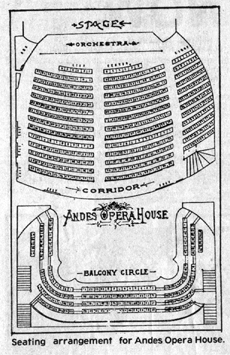
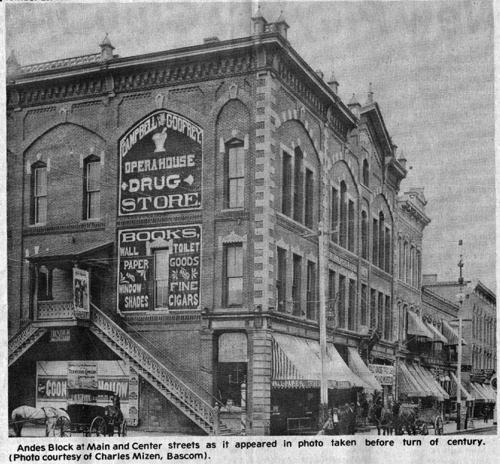
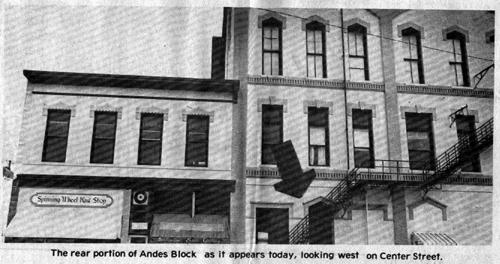
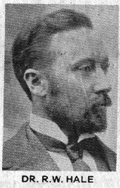
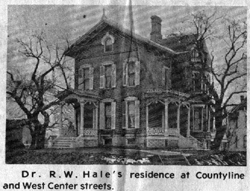
Picture #2 – Andes Block at Main and Center streets as it appeared in photo taken before turn of the century.
Picture #3 – Dr. R.W. Hale
Picture #4 – Dr. R.W. Hale’s residence at Countyline and West Center streets.
Many changes have taken place on West Center Street in Fostoria, the street which divides the town north from south. In earlier Potluck articles (Jan. 7, 14, 21 and 28, 1982), East Center was reviewed. Today’s article starts another series for West Center Street, starting at Main.
Incidentally, your author clocked Main Street in both directions from the center of town to the north and south boundaries. I discovered that from Center at Main to Zeller Road (Township Road 114) where South Main dead ends is 2.1 miles. From Center at Main to Jones Road (Seneca County Road 592) is 1.7 miles. The physical appearance of West Center from Main in the first one and a half blocks has been altered substantially in the last 75 years. A large assortment of businesses and professional people occupied rooms in the buildings in the earlier period of the street’s history, such as: tailors, doctors, lawyers, undertakers and druggists. There were also dyers and cleaners, milliners, bakeries, meat and grocery stores, plumbers, furniture, art goods, insurance, express office, bowling alley, feeds and grain, car dealers, printing shops, bicycle shop and barbers to name some.
The John Andes Block which was built in 1878 at the corner of Main and Center streets is still there. The exterior facelifting which it underwent in 1982 to coincide with the Streetscape program makes it still a very attractive building. Readers can compare that building as it appears today with an earlier period by referring to the accompanying photos.
Admittedly, it cannot be mistaken, but there are some differences from the time that the one accompanying photo was taken in the last century. A prominent change is in the outside stairs which originally led to the second floor from two directions and terminated with a covered veranda. The stairs were still there in the 1920’s, your author recalling how high school kids congregated there to watch people go by.
Note the painted signs on the building for Campbell and Godfrey Opera House Drug Store, located in the first floor corner room where many other drug stores through the years were: Bev. Campbell, Hoffman Bros, and Al Bohrer.
The Andres Opera House occupied the whole top floor of the Andes Block. It has been mentioned many times in Potluck articles and other historical stories through the years…and why not? It provided top-rate stage presentations by professional from New York and Chicago, as they filled engagements in towns and cities along the Baltimore & Ohio Railroad.
Undoubtedly, other sate presentations from other cities also played the Andes Opera House since Fostoria was served by rail facilities running north and south.
Another illustration with today’s photos shows the physical layout of the opera house, which seated 800. It is likely that some of the opera house printed programs are still stashed away with memorabilia in Fostoria homes, in which case your author would like to see them.
The horsedrawn vehicles appearing in the photo confirms the period. Older readers will recall many things about the portion of Main Street showing in the photo of yesteryear, the excellent view looking north and the outside clock located curbside in front of Mergenthaler’s Jewelry Store.
Also in the photo is the Quinn building, just north and adjoining the Andes Block. Quinn’s Bakery was on the first floor of that building where the poolroom is now. The Quinn family lived on the upper floors. John Quinn, the son, became a New York lawyer and a collector of internationally famous artwork. He never returned to reside in Fostoria, but is buried in St. Wendelin Cemetery.
Another photo shows part of West Center Street as it is now. The arrow indicates where Dr. R.W. Hale had his office for many years. He was our family doctor and if it hadn’t been for his resourcefulness when I was a boy, I wouldn’t be writing this story. He pulled me through scarlet fever and diphtheria. When the latter had me in its grip, I recall him telling my mother that if he didn’t administer a new antitoxin I wouldn’t pull through. After injecting a large vile of the drug into me, he said that the critical period would occur some hours later and that either the disease or the drug would conquer. As it turned out the drug won and I’m still here. Perhaps the prayer of my grandmother who held me through the crucial period helped.
In later years, after Hale died when Edison drug Store occupied the corner, Dr. Hale’s offices were taken over by the store which accounts for the door and windows being covered.
Dr. Hale was a prominent citizen as well as doctor, having been a city alderman. Many readers will remember him as their doctor back in the days when all doctors made housecalls. Hale’s father was a doctor before him and his son became a doctor in Baltimore, MD. One of the accompanying photos shows the Hale residence, Countyline at Tiffin Street, where the 7-11 Store is now.
NUMBER 112
The “now” photo shows where The Spinning Wheel Knit Shop is at 112. Others to occupy that location in the past were: The Sanitary Dye House and Dry Cleaning which was established by Mr. Bishop, father of L.A. Bishop who later moved to West North Street where the son had it for many years and was succeeded by Gordon Dennis, his son-in-law.
Others to occupy that location were: Children’s Toy Shop, Grace Myers Millinery Shop, Carl Smith and Office Supply Shop, Kleinhen & Son Real Estate and Office Supply and Christian Science Reading Room and perhaps others I was unable to locate.
The store room to the right of The Spinning Wheel is the rear entrance to what is now Gary’s Men’s Wear and Sporting Goods and was or Mose Lamfrom Clothing Co. before then, and still earlier for the Wagner Clothing Co.